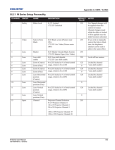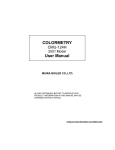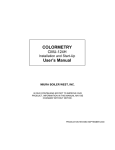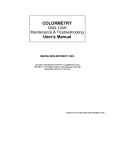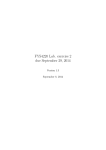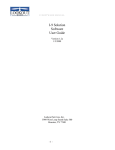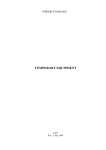Download COLORMETRY User`s Manual
Transcript
COLORMETRY CMU-124H General Information User’s Manual MIURA BOILER WEST, INC. IN OUR CONTINUING EFFORT TO IMPROVE OUR PRODUCT, INFORMATION IN THIS MANUAL MAY BE CHANGED WITHOUT NOTICE. PUBLICATION REVISED SEPTEMBER 2000 Introduction We appreciate your purchase of the Colormetry system. This user’s manual covers instructions for the use of your Colormetry system. Please read through this manual and understand the contents before using the system. We also recommend that the manual be kept nearby for reference when operating the Colormetry system. Operate the system only in accordance with the instructions given in this manual. We will under no circumstances whatsoever be liable for damages arising from the user's failure to follow the instructions given in this manual. (Some details of the instructions contained in this manual may be different from the actual system purchased. The instructions are also subject to change without prior notice.) CAUTION The Colormetry system is a hardness-leakage monitoring system that monitor the harness of water and issues hardness-leakage alarm. It is not a system that remedies (effects recovery from) hardness leakage itself. i How this manual is organized This manual consists of ten chapters listed below. We recommend that you familiarize yourself with the objectives and contents of each, and keep the manual handy for reference. Organization Chapter 1 Safety Warnings and Precautions Explains the danger and precautionary signs and notes that apply to the handling, installation, wiring and maintenance of the Colormetry system. Chapter 2 Specifications Gives specifications and depicts the overview and external view of the Colormetry system. Chapter 3 Description Summarizes the Colormetry system and explains the monitoring methods, functions, remote signal applications and evaluation method. It answers the question “What is the Colormetry system?” Chapter 4 Warranty Warranty and registration on card. ii Table of contents Chapter 1 Safety warnings/Precautions ...........................................................................1 Chapter 2 Specification ......................................................................................................3 2-1 Specifications ..............................................................................................................................4 2-1-1 General specifications .......................................................................................................4 2-1-2 Physical data .....................................................................................................................4 2-1-3 Monitoring capabilities .......................................................................................................4 2-1-4 Supply and drain water......................................................................................................4 2-1-5 Accessories (Refer to “Before You Start,” for further details.) .........................................4 2-2 Overview .....................................................................................................................................5 2-2-1 Colorimetry system configuration ......................................................................................5 2-2-2 External appearance of reagent cartridge.........................................................................7 Chapter 3 3-1 3-2 3-3 3-4 3-5 Chapter 4 4-1 4-2 Description.........................................................................................................9 Outline .......................................................................................................................................10 3-1-1 Summary of Colormetry system ......................................................................................10 3-1-2 Summary of Colormetry layout........................................................................................10 3-1-3 Operating principle of Colormetry....................................................................................11 Highlights of features.................................................................................................................12 Method and examples of utilizing the remote signals ...............................................................14 3-3-1 About the remote signals.................................................................................................14 3-3-2 Detailed descriptions of remote signals ..........................................................................15 3-3-3 About the remote signal’s delay time ..............................................................................17 About Colormetry monitor time .................................................................................................18 3-4-1 Automatic monitoring.......................................................................................................18 3-4-2 Manual monitor................................................................................................................20 How ionic concentration is evaluated........................................................................................21 3-5-1 How a normal evaluation is processed ...........................................................................21 3-5-2 How an abnormal evaluation is processed .....................................................................22 Warranty...........................................................................................................27 Written warranty ........................................................................................................................28 Warranty registration card.........................................................................................................29 iii iv Chapter 1 Safety Warning/Precautions Explains the danger and precautionary signs and notes that apply to the handling, installation, wiring and maintenance of the Colormetry system. 1 This sign indicates a situation in which incorrect handling might result in death or injury to the operator, or that may result in damage to property. WARNING CAUTION This sign indicates precautions for the prevention of damage to the equipment. NOTE Instructions for effective operation and information that may become useful are explained here. 2 Chapter 2 Specifications Gives specifications and depicts the overview and external view of the Colormetry system. 2-1 Specifications.................................................................................................................................................4 2-2 Overview ........................................................................................................................................................5 3 2-1 Specifications 2-1-1 General specifications Power-supply voltage: Power consumption: Power-supply fluctuation: Ambient operating temperature: Ambient storage temperature: Raw water temperature: Humidity: Raw water pressure: AC 24 V, 50/60 Hz, single-phase 20 W (during monitoring) ±15% 41°F ~ 122°F (5°C ~ 50°C) 14°F ~ 122°F (-10°C ~ 50°C) (must be without dew condensation in the main unit) 41°F ~ 104°F (5°C ~ 40°C) 20% min.-- 90% max. RH without ice or dew condensation 7.1 ~ 71 psi (0.05 ~ 0.5 MPa), (0.5 ~ 5 kg/cm2) 2-1-2 Physical data Installation method: External dimensions: Mass: Indoor, wall mounted 5” (W) X 4” (L) X 20-1/4” (H) (125 mm (W) X 100 mm (L) X 515 mm (H) ) 4.6 lb (2.1 kg) 2-1-3 Monitoring capabilities Evaluation method: Evaluation ranges: Via the colorimetric method Hardness displayable in 3 ranges: 0 – 1 mg/L, 1 – 2 mg/L, and 2 mg/L and up Alarm ranges: 1 mg/L and up, and 2 mg/L and up (Select either one) Reagent cartridge replacement cycle: Approximately every 4 months * Based on hourly monitoring, 24 hours a day Alarm output: Sounding of a buzzer and SPDT contact Contact capacity: AC 24 V (use the supplied transformer to step down from the AC 100 V to 24 V and supply 24 V to the main unit), 1 A, dry contact Signal output during monitoring: Open-collector output (capacity: DC 24 V, 70 mA) Remote signal input: AC 24 V with voltage, “A” or “B” contact input 2-1-4 Water-feed and drainage Fiber filter: Constant-flow regulator valve: Feed-water connection diameter: Drain-water connection diameter: Cartridge type (standard accessory) Material: Polyethylene Material: EPDM For connecting 1/4” (6 mm) external dia. pipe (supplied) For connecting 5/16” (8 mm) external dia. pipe (supplied) 2-1-5 Accessories (refer to “Before you start,” for further details.) • Reagent cartridge • Feed-water pipe, 1/4” (6 mm) dia., 16.4 ft. (5 m) long • Drain-water pipe, 5/16 (8 mm) dia., 9.8 ft (3 m) long • Filter casing and fiber filter (cartridge type) • Ball valve and other plumbing part • Installation parts for wall-mounting bracket and other miscellaneous parts • Operator’s instruction plate 4 2-2 Overview 2-2-1 Colormetry system configuration Reagent cartridge Cartridge lever LCD display Manual monitor switch (Buzzer reset switch) Front cover Front cover fixing screws Filter assembly 5 6 2-2-2 External appearance of reagent cartridge Tube X-Ring Tube Reagent injection nozzle 7 External view of filter casing Filter-casing assembly O-ring Fixed flux valve (black rubber plate installed on the top) Tube joint Filter-casing assembly Filter casing (top) O-ring Filter cartridge 8 Filter casing (bottom) Chapter 2 Description Summarizes the Colormetry system and explains the monitoring methods, functions, remote signal applications and evaluation method. It answers the question “What is the Colormetry system?” 3-1 Outline ........................................................................................................... 10 3-2 Highlights of features..................................................................................... 12 3-3 Method and examples of utilizing the remote signals ................................... 14 3-4 About Colormetry monitor time ..................................................................... 18 3-5 How ionic concentration is evaluated............................................................ 21 9 3-1 Outline 3-1-1 Summary of Colormetry system The Colormetry system monitors the concentration of ions and others in water through the use of Colormetry. In a Colormetry process the ionic and other concentration in water is monitored by allowing a reagent to react against the target ions and others, and monitoring the transmissivity of the resultant coloration for light of a specific wavelength. An example procedure is to check for hardness leakage via the coloration of a hardness indicator. The Colormetry system electronically automates the entire process. Basically, the system has been developed as part of a processing system for boiler water. Colormetry automatically and regularly implements the process of sampling the water, injecting the reagent, stirring and evaluating the result, thereby obviating the conventional manual procedure. The system allows the detection of low-level ionic concentrations, reducing maintenance to the minimum. The system has been designed with emphasis on the reliability of the monitoring results. The manually selectable conditions--for instance, to verify monitoring upon the detection of hardness leakage--prevent temporary fluctuations from triggering alarms. Other features include the external alarm output, DDI-compatible, self-diagnostic function, and message display, as well as the suspension (by remote signal input) of monitoring while the water softener is regenerating or the water feed is stopped. Refer to 3-2, “Highlights of features” on page 12. 3-1-2 Summary of Colormetry layout Colormetry consists of the reagent cartridge (the indicator), reagent injector mechanism, monitoring system and water-feed and drainage systems. Colormetry layout Reagent cartridge (Indicator) Solenoid valve Reagent injection Nozzle Fixed flux Tube Sample water Filter Light source Feed water Drain system Photoreceptor Feed-water system Agitator Electromagnetic induction coil 10 Drain 3-1-3 Operating principle of Colormetry The Colormetry system operates as follows: Washes and fills a monitor chamber with sample water. Injects reagent and stirs the sample. Monitors light transmitted through the sample. Evaluates the water's hardness. Displays the result. [1] Washing and filling the monitor container with sample water A solenoid valve opens, filling the monitor container with sample water. The old sample water remaining in the container is pushed out, and the container is washed at the same time. [2] Injecting reagent and stirring sample water The solenoid valve closes, and the injection pump injects the reagent into the sample water. The stirrer coil, activated at the same time, mixes the water and reagent. The reagent causes coloration of the sample water in accordance with the hardness components of the water. [3] Monitoring the sample water A light source is activated to project light into the sample water. The light receptor electronically monitors the light transmitted through the sample water. The intensity of the transmitted light varies, depending on the color of the sample water. These variations are caused by light absorption in the water, which varies with the color of the water. [4] Evaluating the concentration and displaying the result The concentration is evaluated from the monitoring value, and the result is indicated on the LCD display. 11 3-2 Highlights of features The Colormetry system has the following features: [1] Monitors hardness leakage automatically • [2] Requires no periodic calibration • [3] The monitoring process is fully automated, saving a significant amount of work by eliminating the need for complicated manual procedures. The system needs no cumbersome periodic calibrations. Includes a built-in timer (Refer to the setting instructions in Section 3-3, “Setting modes,” on page 26 of the Installation and Start-Up Manual.) • • [4] Monitoring period may be set as desired (e.g., daily between 9 a.m. and 5 p.m.). Interval for each monitoring may set as desired. (The interval is selectable in 30-minute increments between 30 and 180 minutes.) Detects low concentrations of hardness leakage (Refer to Section 3-5, “Evaluation method,” on page 21 for details.) • [5] The evaluation ranges are 0 – 1 mg/L, 1 – 2 mg/L and 2 mg/L and up. Evaluates hardness leakage at higher accuracy (Refer to Section 3-5, “Evaluation method,” on page 21 for details.) • • [6] The alarm set point may be set to activate either on “1 mg/L and over” or “2 mg/L and over.” When an abnormal condition is detected, monitoring is repeated a number of times (called abnormal-condition retries; selectable between one and three times) to prevent a temporary fluctuation from triggering an alarm. In addition, such an abnormality must be repeated in a series of monitoring at a preset interval for a number of times (called response (alarm) cycle; also selectable between one and three times). When all of these monitoring results indicate an abnormal condition, it is evaluated that hardness leakage exists and the alarm is issued. Indicates data on the display screen (Refer to Chapter 4, “Digital display description,” on page 32 of the Maintenance and Troubleshooting Manual for details.) • The display indicates the abnormality, as evaluated, and the causes of major system problems. 12 [7] Offers a self-diagnostic function (Refer to Section 3-5-2, “How the system operates in evaluating an abnormal condition,” on page 22 for details.) • • [8] When it is evaluated that there is a hardness leakage, the buzzer sounds. SPDT contact may also be used to send an alarm remotely. If a problem occurs in the system, a typical cause will be displayed in the same manner as the hardness leakage. Stores historical records of hardness leakage (Refer to Section 3-3, “Verifying error records,” on page 27 of the Maintenance and Troubleshooting Manual.) • [9] The system stores the records of occurrence date and time, duration, and recovery date and time for each of the three latest incidents of hardness leakage. The records may be utilized to analyze the causes of hardness leakage. Requires minimal maintenance (For details, refer to Section 2-3, “Replacing reagent cartridges,” on page 7 of the Maintenance and Troubleshooting Manual.) • The reagent cartridge may be replaced using a one-touch action. The reagent needs no replacement for approximately four months in typical applications. (Note that more frequent replacement may be necessary, depending on the application.) [10] Compact in design, easy to install (For details, refer to Section 2-2, “How to install the main unit,” on page 5 of the Installation and Start-Up Manual.) • • • The main unit is installed easily on a wall. Installation is a simple process. It is the most compact design ever for a system of this type. [11] About advanced features Colormetry offers the following features: • Remote signal input function (refer to Section 2-4-3, “Remote signal input,“ on page 14 of the Installation and Start-Up Manual.) Connecting the remote regeneration signal from water softener prevents a false detection that can occur, for instance, while the water softener is regenerating, thus providing more accurate evaluation. • External-alarm master contact output The alarm’s contact output may be used to transmit a hardness-leakage alarm to a remote location. • In-monitoring output (DDI compatible) A system output is available during monitoring. (Refer to Section 2-4, "How to wire the system,” on page 11 of the Installation and Start-Up Manual for function input.) 13 3-3 Method and examples of utilizing the remote signals (For specific signal input methods, refer to Section 2-4-3, “Remote signal input,” on page 14 of the Installation and Start-Up Manual.) 3-3-1 About the remote signals Monitoring while the water softener is regenerating may erroneously indicate hardness leakage. An attempt to monitor with the water feed stopped would return either hardness leakage in stagnant water in the plumbing or a system error due to a lack of flow. Conventional hardness leakage alarm system suffered from such detection errors and required the false alarm to be manually reset. The Colormetry system provides the following two methods, which may be used simultaneously, to avoid false alarms: <Method No.1: Utilizing the timer function> Monitor Start time [SStart] and Monitor stop time [SStop] settings limit the period during which monitoring is performed. The provision helps avoid the regeneration time and off-hours of the water softener. Example Given the water softener settings of Regenerating time: 11:00 p.m. Boiler operating period: 8:00 a.m. through 5:00 p.m. ↓ Set Monitor Start time [SStart] at 8:00 a.m., and stopping time at 5:00 p.m. (No monitoring by the Colormetry system at 11:00 p.m.) <Method no. 2: Utilizing the remote signal feature> Connecting the external contact with voltage may allow Colormetry monitoring only while the water softener is turned on, or to suspend monitoring while the water softener is regenerating. (If no voltage is available through an external contact closure, the Colormetry power supply may be utilized.) The purpose of remote signals: To prevent a false detection while the water softener is regenerating or the feed water is stopped. 14 3-3-2 Detailed descriptions of remote signals The remote signal input may be processed to enable monitoring in either two methods - (1) the off state, or (2) the on state. The two processing methods are selectable in the Setting mode [Set Mode]. Both methods achieve the same objective (of preventing false detections), though they process the signal differently. [1] Monitoring is enabled by remote signal being turned Off [SRte Sgl Off] (the factory setting) ✩ The off state of the remote signal input (the external contact is open, giving no voltage input) permits scheduled monitoring at Monitor interval [SIntvl] as preset in Setting mode [Set Mode]. ✩ Monitor interval [SIntvl] may be set in 30-minute increments up to 180 minutes. (Refer to Section 3-3, “About items to be set in Setting mode,” on page 26 of the Installation and Start-Up Manual.) Example: Inputting a remote regeneration signal from water softer. Connecting a water-softener contact, if available, to the Colormetry system as a remote signal input, which turns on (closes) during regeneration, will disable scheduled monitoring. When the softener contact turns off (opens) at the completion of regeneration (that is, the remote signal is off), scheduled monitoring is again enabled. [2] Monitoring is enabled by Remote-Signal On [SRte Sgl On] The on state of the remote signal input (the external contact closes, inputting a voltage to the Colormetry system) will enable monitoring at Monitor interval [SIntvl]. Example No. [2]-1: Inputting the feeding water (to a water softener, etc.) signal Connecting a contact, if available is being turned a water softener or the like, which turns on (closes) while feeding water, to the Colormetry system as a remote signal input, will enable monitoring only while feeding water. When the feed water stops or the softener regenerates, and the contact turns off (opens), no scheduled monitoring is performed. Example No. [2]-2: Inputting a control signal of motor valve or solenoid valve An input signal from a motor valve or solenoid valve that controls the feed water will enable monitoring only while the valve is open and signal is in the on state (contact is closed). Example No. [2]-3: Inputting a supply tank water-level control signal When a “Requesting feed water” signal is input from the equipment that controls the water level of a supply tank, monitoring is performed only for the duration of the request (that is, while feeding water). 15 NOTE It is recommended to connect a remote signal wherever possible to prevent false detections and avoid recovery operations. The signal for adding water, if available, should be connected as the first priority. If only remote regeneration signal from water softer is connected, a false detection of hardness leakage may result from monitoring the stagnant water while the water is stopped, or a system error may occur due to the lack of flow. A remote signal-input arrangement, as shown in examples [2]-1 and [2]-2, is recommended. CAUTION If no remote signal is connected, be sure to set "the monitoring is enabled by remote signal being turned off" [SRte Sgl Off] mode (which is the factory setting). 16 3-3-3 About the remote signal delay time The purpose of Remote-signal delay time [SRte Sgl dl]: The setting determines the number of seconds the monitoring is to be delayed following the remote signal input. The delay function is not normally required except for preventing false evaluation, especially in the example shown below. Example of delay: It is recommended that the Colormetry sample be taken off as close to the water softener outlet as practical. (Refer to Chapter 2, “Installation,” on page 3 of the Installation and Start-Up Manual for details.) In a case, however, where the sample is taken, as illustrated, off the secondary of a motor valve or the like, requiring a certain amount of time to open fully, a wash-flow error [Wash Flow F] may occur due to insufficient sample-water pressure when the remote signal is first connected. (For details on setting the delay, refer to Section 3-3, “About items to be set in Setting mode,” on page 26 of the Installation and Start-Up Manual.) Remote signal Motor valve Raw water Softened water Colormetry system Water softener Sample water for Colormetry system Drain water from Colormetry To prevent such a problem, select Remote signal delay time [SRte Sgl d1] setting and ensure the required pressure (7.1 ~ 71 psi) buildup at the Colormetry inlet (0 ~ 30 seconds). 17 3-4 About Colormetry monitor timing 3-4-1 Automatic monitoring The basic interval at which the Colormetry system monitors is set in Monitor interval [SLntvl] setting (settable in 30-minute increments over the 0 ~ 180 min. range; refer to Section 3-3 on page 26 of the Installation and Start-Up Manual). Monitor Start time, which occurs at Monitor interval [SIntvl], will be referenced to the occurrence of one of the events listed below. The actual monitor time occurs after the time set in Setting mode [Set Mode] elapses following the reference event. a. When the power is first turned on. b. Upon resetting. c. When the Monitor interval [SIntvl] setting is changed to a smaller value (a shorter interval) than the current value. [1] If no remote signal is connected Monitoring is performed at Monitor interval [SIntvl]. [2] If a remote signal is connected a. If the remote signal setting is for “Monitoring is enabled by remote signal being turned off” [SRte Sgl Off]: (Example of remote signal – Remote regeneration signal from water softener) • If the remote signal has been off continuously and for longer than specified in the Remote-signal delay time [SRte Sgl dl] setting at the monitor time following Monitor interval [SIntvl], actual monitoring will start. • If, on the other hand, the remote signal has been on at a monitor time after Monitor interval [SIntvl] lapses, the system will enter monitor standby mode until the remote signal goes off. After the remote signal goes off, actual monitoring will start when the remote signal has remained off as long as set in the Remote-signal delay time [SRte Sgl dl] setting. Remote-signal delay time [SRte Sgl dl]: 10 sec. Monitor interval [SIntvl]: 60 min. Monitor time No monitoring Monitoring Monitor interval Monitoring Monitor time Monitor interval 60min 60min 10sec 10sec Remote signal ON Water softener is regenerating OFF 18 10sec b. If the remote signal setting is for “Monitoring is enabled by remote signal being turned on“ [SRte Sgl On]: (Example of remote signal – Remote regeneration signal from water softener) • If the remote signal has been on continuously and for longer than specified in the Remote signal delay time [SRte Sgl dl] setting at a monitor time following Monitor interval [SIntvl], actual monitoring will start. • If the remote signal is off at a monitor time following Monitor interval [SIntvl], the system enters Monitor standby mode until the remote signal turns on. After the remote signal switches on, actual monitoring will start when the remote signal has remained on as long as set in Remote signal delay time [SRte Sgl dl] setting. Remote-signal delay time [SRte Sgl dl]: 10 sec. Monitor interval [SIntvl]: 60 min. Monitor time No monitoring Monitoring Monitor interval Monitor time Monitoring Monitor interval 60min 60min 10sec 10sec 10sec Remote signal ON OFF For details of remote signals and remote signal delay time, refer to Section 3-3, “Method and examples of utilizing the remotes signals,” on page 14 of this manual. Precautions on operation Where a remote signal is connected, if the remote signal turns to disable monitoring after the solenoid valve in the Colormetry system turns to closed state from the open state (from water discharging from the drain tube to the stopping of drainage), the monitoring results will remain valid. The monitoring results before the solenoid valve enters the closed state (stopping water discharge from the drain tube) will be processed as follow: (If the remote signal turns to disabling monitoring, the monitoring process will still be carried out to completion.) a. If the concentration is evaluated as being lower than the Alarm set point (setting): The result will be displayed as usual. b. If the concentration is evaluated as being higher than the Alarm set point (setting): The evaluation is invalidated and a blank bar (“Result: -----“) is displayed. 19 [3] If the Monitor Start time [SStart] and Stop time [SStop] are set up (when the timer function is used) a. If it becomes the Monitor time after the Monitor interval [SIntvl] has elapsed, but not Monitor Start time yet, the system will enter Monitor standby mode until Monitor Start time, at which point monitoring will be performed. b. If no remote signal is connected, monitoring will be performed at Monitor interval [SIntvl] only during the period between Monitor Start time [SStart] and Stop time [SStop]. c. If a remote signal is connected, monitoring will be performed in the same manner as in paragraph 2 above, “If a remote signal is connected,” only during the period between Monitor Start time [SStart] and Stop time [SStop]. Example: Monitor start time [SStart] Monitor stop time [SStop] Monitor interval [SIntvl] Monitoring is enabled by remote signal being turned on Remote signal delay time [SRte Sgl dl] No monitoring AM 8:00 PM 6:00 60 min. [SRte Sgl ON] 10 sec Monitor time Monitor time Monitoring AM 8:00 No monitoring AM 9:00 10sec Remote signal 10sec ON OFF d. If it becomes Monitor stop time [SStop] during the monitoring process, the system will enter Monitor standby mode upon the completion of that monitoring. CAUTION If the remote signal setting is for “Monitoring is enabled by remote signal being turned on" [SRte Sgl On], periodically check to verify that automatic monitoring is performed. If no remote signal is available due to a signal problem, the monitoring process will never be initiated. 3-4-2 Manual monitor Press the “Manual Monitor” switch to monitor regardless of the Monitor interval, Remote signal, Monitor start or stop time settings. (The monitoring process will not be initiated, if the cartridge is out. The system may initiate the status-verification test on a system error.) 20 3-5 How ionic concentration is evaluated The system evaluates ionic concentrations in three levels: 0 – 1 mg/L, 1 – 2 mg/L, and 2 mg/L and up. Alarm set point may be set to trigger either at 1 mg/L and up, or 2 mg/L and up. The evaluation method is the same for the automatic and manual monitor. 3-5-1 How a normal evaluation is processed If an a monitoring result is below the Alarm set point [SAlarm Set], as set in Setting mode [Set Mode], it will be evaluated as normal. The result of such evaluation will be displayed and monitoring is complete. They system enters Monitor standby mode after two minutes upon completion of monitoring. Mode Sample LCD display Std-by: 0-1 mg/L Monitor standby Monitor Monitor On If monitoring result < Alarm set point [SAlarm Set] Displaying evaluation result After two minutes Result: 0-1 mg/L Monitor standby Name of mode Displaying evaluation result Monitor standby Display indication (a sample) Std-by: 0-1 mg/L Alarm* Bz* Remarks To be displayed for two minutes following monitoring (Note 1) To be displayed two minutes after Std-by: 0-1 mg/L OFF OFF monitoring (Note 1) * Alarm: External-alarm master-contact output Bz: Buzzer output Result: 0-1 mg/L OFF OFF Note 1: The sample display, shown in the table, represents an evaluation within the 0 – 1 mg/L range. If the alarm set point is set at 2 mg/L and it is evaluated to be in the 1 – 2 mg/L range, the LCD display will read [******** 1-2mg/L]. 21 3-5-2 How the system operates in evaluating an abnormal condition [1] If an evaluation result exceeds alarm set point [SAlarm Set] (the “1 mg/L and up,” or “2 mg/L and up” setting), monitoring is repeated the number of times as set (between one and three times) in alarm set point [SAlarm Inc] setting. If all retry results have exceeded alarm set point [SAlarm Set], only then will the monitor result will be determined abnormal. If, on the other hand, all retry results are lower than alarm set point [SAlarm Set] setting, the condition will be determined to be normal and monitoring will be terminated. [2] However, an abnormal evaluation made in step (1) alone would not trigger an abnormal-condition alarm (that is, to sound buzzer and close the slave-remote output contact). An abnormal-condition alarm is given only on the occurrence of an abnormal condition repeated for Response (alarm) cycle [SAlarm Det] (selectable between one and three times) in automatic monitoring at Monitor interval [SIntvl] (selectable between 30 and 180 minutes in 30-minute intervals) or in manually initiated monitoring. Monitor standby Monitor Num. of monitoring performed < N1 YES Std-by: 0-1 mg/L Monitor On N1: Abnormal condition retries [SAlarm Inc] N2: Response (alarm) cycle [SAlarm Det] NO Num. of abnormal condition retries < N2 NO Result: 0-1 mg/L Std-by: 0-1 mg/L YES Displays evaluation result. Displays evaluation of result processes alarm Result: 0-1 mg/L After two minutes After two minutes Monitor standby Monitor standby 22 Std-by: 0-1 mg/L [3] If an abnormal condition occurs repeatedly in a series of automatic monitoring at Monitor interval [SIntvl], or in manually initiated monitoring, the abnormal-condition alarm will stay on continuously. [4] An abnormal-condition alarm is automatically terminated (the buzzer stops and the slave alarm’s output-contact opens) upon that the condition is determined normal in automatic monitoring at Monitor interval [SIntvl], or in manually initiated monitoring. Example of Monitor no. 1: Abnormal-condition retry [SAlarm Inc] setting: 2 Response cycle [SAlarm Det] setting: 2 Monitor interval [SIntvl] Monitor interval [SIntvl] Condition is evaluated to be abnormal Normal condition Monitor A Monitor interval [SIntvl] Abnormal-condition alarm is issued Abnormal-condition alarm is terminated Condition is evaluated to be abnormal Condition is evaluated to be abnormal Abnormal condition Abnormal condition Abnormal condition Abnormal condition Abnormal condition Abnormal condition Monitor B Monitor C Monitor D Monitor A: The result is below the alarm set point (setting), and therefore the condition is deemed to be normal. Monitor B: The result has exceeded the alarm set point. Since the abnormal condition retry setting is for two times, another monitoring is performed, which again exceeded the alarm set point. The condition in monitor B is therefore evaluated to be abnormal. Monitor C: As was the case with monitor B, the first two results have exceeded the alarm set point. The result of monitor C, therefore, is also evaluated to be abnormal. An abnormal condition has been verified twice -- in monitor B and C -- so that an abnormal-condition alarm is now issued. Monitor D: The result has exceeded the alarm set point on two consecutive occasions. The subsequent result has again been evaluated as an abnormal condition, following an already issued abnormal-condition alarm. Therefore, the alarm will continue. 23 Example of monitor no. 2: Abnormal condition retry [SAlarm Inc] setting: 3 Response (alarm) cycle [SAlarm Det] setting: 1 Monitor interval [SIntvl] Monitor interval [SIntvl] Monitor interval [SIntvl] Abnormal-condition alarm is issued Abnormal-condition alarm is terminated Condition evaluated to be abnormal Abnormal condition Normal condition Abnormal condition Abnormal condition Normal condition Monitor A Abnormal condition Abnormal condition Monitor B Monitor C Normal condition Monitor D Monitor A: The result is below the alarm set point (setting), and therefore the condition is considered normal. Monitor B: The result has exceeded the alarm set point. Since the abnormal-condition retry setting is for three times, another monitoring is performed, which again exceeded the alarm set point. The third retry result, however, is below the alarm set point, and so passes as normal. Monitor B is therefore evaluated to represent a normal condition. Monitor C: The first three results have exceeded the alarm set point. With an abnormal condition verified once, an abnormal-condition alarm is now issued. Monitor D: The result is below the alarm set point. Since the result has been evaluated to be normal, the abnormal-condition alarm is now automatically terminated. Remarks: If a result has exceeded the alarm set point but a subsequent result is invalidated so that the series of monitoring fails to satisfy the abnormal-condition retry [SAlarm Inc] requirement, the evaluation of the session will still be abnormal. 24 3-5-2-1 Display and output on abnormal condition (Note 1) Name of mode Displaying evaluation result Monitor standby Display indication (a sample) Alarm* Bz* Remarks To be displayed for two minutes following monitoring (Note 2) To be displayed two minutes after Std-by: > 2 mg/L OFF OFF monitoring (Note 2) * Alarm: External-alarm master-contact output Bz: Buzzer output Result: > 2 mg/L OFF OFF Note 1: The sample indications shown in the table will remain displayed from the time of evaluating an abnormal condition until the abnormal condition alarm is issued. Note 2: The sample display represents an evaluation exceeding 2 mg/L. If the alarm set point is set at1 mg/L and the condition is evaluated to be in the 1 – 2 mg/L range, the LCD display will read [******** >1 mg/L]. 3-5-2-2 Display and output on abnormal evaluation (refer to Section 3-5-2, “How the system operates in evaluating an abnormal condition,” on page 22 of this manual.) a. In an abnormal-condition alarm, the buzzer sounds and the external alarm’s master contact closes. b. When an abnormal-condition alarm is issued, pressing the Buzzer Reset switch on the front of the main unit will stop the buzzer. The external-alarm’s master contact, however, will remain closed until the condition is evaluated as normal in an automatic monitoring at Monitor interval [SIntvl], or monitoring initiated manually. c. Once the buzzer is stopped by pressing the Buzzer Reset switch, it will remain disabled even if the immediately subsequent evaluation happens to be abnormal. If, however, a condition is once evaluated as normal in automatic monitoring at Monitor interval [SIntvl] or manually initiated monitoring, then a subsequent occurrence of the abnormal-condition alarm will sound the buzzer. Name of mode Display indication (a sample) Displaying evaluation result Warning: > 2 mg/L Monitor standby Warning: > 2 mg/L Alarm* Bz* ON ON Remarks (Note 1) This is the result of pressing, the Buzzer reset switch once. * Alarm: External-alarm master-contact output Bz: Buzzer output ON OFF Note 1: The sample display represents an evaluation exceeding 2 mg/L. If the alarm set point is set at 1 mg/L and it is evaluated to be in the 1 – 2 mg/L range, the LCD display will read [******** >1 mg/L]. If the abnormal-condition alarm has been issued, the LCD display will remain the same even after two minutes have elapsed. 25 3-5-2-3 Workings of hardness leakage alarm and action to take Hardness leakage alarm occurs. Buzzer starts sounding. External-alarm contact turns on. YES Is the Buzzer Reset switch on? (Note 1) NO Buzzer sounds. Buzzer strops. Evaluation result is displayed. (Monitor standby) Note 1: The Buzzer Reset switch also functions as a manual monitor switch. [1] The buzzer sounds on the occurrence of an abnormal condition. [2] The buzzer stops on pressing the Buzzer Reset switch. (The system will not automatically enter Manual monitor mode at this time. To start manual monitor, press the Buzzer Reset switch again.) (The LCD display will remain the same.) NOTE External-alarm master contact will not be cancelled until the condition is evaluated as normal. 26 Chapter 4 Warranty To have the product covered by the warranty, fill out the Warranty Registration card and mail to MIURA BOILER WEST, INC. immediately following the installation. 4-1 Written Warranty ........................................................................................... 28 4-2 Warranty Registration Card........................................................................... 29 27 Warranty of The Miura Boiler West, Inc. Colormetry 1 Year Limited Warranty Miura Boiler West, Inc. (Miiura), at its sole option, will repair or replace at no charge any Miura’s Colormetry, if found to be defective in workmanship or material within twelve months from the date of purchase. To qualify for this warranty, the purchaser must return Miura’s warranty card together with a copy of the invoice from the supplier which is dated within one month of the date of purchase. This warranty does not extend to the cartridge of the Colormetry. To qualify for this warranty, the Colormetry must be operated in accordance with the conditions of service specified in Miura’s Manuals and addendums. Furthermore, hardness in the water must have been checked by titration or any other method at least once a week and recorded to ascertain that the Colormetry is running correctly. Miura will not be responsible for the purchaser’s failure to conduct the above routine checking and recordation, and any failure to detect the malfunction of the Colormetry is the sole responsibility of the purchaser. This warranty will not be applicable if any repairs are performed by any one other than an authorized Miura technician or if any parts other than Miura approved parts have been installed. All claims for warranty are to be presented in writing to Miura for review within fifteen days of discovery of any defects. The above limited warranty is extended by Miura to the original purchaser only and is not assignable or transferable to subsequent purchasers or lessees. MIURA EXTENDS NO WARRANTY OF ANY KIND, EXPRESS OR IMPLIED, INCLUDING ANY IMPLIED WARRANTY OF MERCHANTABILITY OR SUITABILITY FOR PURPOSE WITH RESPECT TO THE COLORMETRY OR WITH RESPECT TO SERVICES PROVIDED BY MIURA. EXCEPT AS PROVIDED HEREIN, UNDER NO CIRCUMSTANCES WILL MIURA BE LIABLE TO PURCHASER UNDER ANY TORT, NEGLIGENCE, STRICT LIABILITY, CONTRACT OR OTHER LEGAL OR EQUITABLE THEORY, FOR ANY LOSS OF USE, LOSS OF TIME, INCONVENIENCE, COMMERCIAL LOSS, LOST PROFITS OR SAVINGS OR OTHER INCIDENTAL, SPECIAL OR CONSEQUENTIAL DAMAGES ARISING OUT OF THE USE OR INABILITY TO USE THE COLORMETRY OR FOR PURCHASER’S COST OF EFFECTING COVER, TO THE FULL EXTENT SUCH MAY BE DISCLAIMED BY LAW. PURCHASER SHALL INDEMNIFY AND HOLD HARMLESS MIURA, ITS OFFICERS, AGENTS AND EMPLOYEES FROM AND AGAINST ANY AND ALL LIABILITIES, DAMAGES AND LOSSES, INCLUDING COSTS AND EXPENSES IN CONNECTION THEREWITH, FOR DEATH OF OR INJURY TO ANY PERSONS WHOMSOEVER AND FOR THE LOSS OF, DAMAGE TO OR DESTRUCTION OF ANY PROPERTY WHATSOEVER, CAUSED BY, ARISING OUT OF OR IN ANY WAY CONNECTED WITH THE USE OF THE COLORMETRY BY PURCHASER. MIURA BOILER WEST, INC. 28 Miura Boiler Colormetry Warranty Registration Card Purchased from_________________________________ Your name_____________________________________ Street Address_____________________________________________________________________ City________________________________State____________Zip___________________________ Date Purchased_____________________Where Installed___________________________________ Colormetry will be used for: ___________________________________________________________ Signature_____________________________________ MARKET SURVEY What brand of boilers do you currently operate? Manufacturer:____________________________Boiler HP:__________________________________ What distributor or Eng. Company did you buy the boilers from. _________________________________________________________________________________ How many years have you used them for:________________________________________________ Are they: (circle) Water tube Fire tube Steam generator Coil tube What pressure do you operate your boilers at? ____________________psi What do you like about them? _________________________________________________________________________________ What do you dislike about your boilers? _________________________________________________________________________________ What type of fuels do you use in boilers? (circle) Ngas #2Oil #6Oil Amber Propane IF YOU LIKE THEM, please tell us who does the following for you: Water Treatment (Chemicals)__________________________________________________________ Boiler Maintenance__________________________________________________________________ Installation/Construction______________________________________________________________ Water Softener maker________________________________________________________________ Do you have any plans for buying boilers in the near future? _________________________________________________________________________________ 29


































